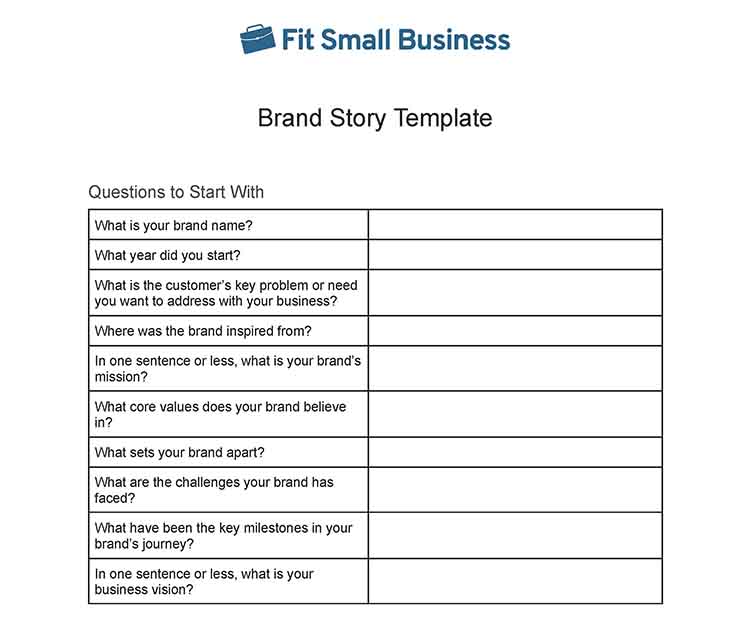More and more businesses are finding out that it’s easier to connect with an audience if they see you as more than just someone who sells to them. Writing a brand story will allow you to share your business’ mission, values, and purpose—without making it seem like a sales pitch. An effective brand story is a powerful tool that connects your business to your customers on a deeper, more personal level. But how do you create a brand story? Follow the outline below and download the free template to get you started.
Here is a brief outline of every good brand story:
- The pain point: Your business started because you recognized a problem potential customers were suffering—the pain point.
- Identifying a solution: Because of the pain point you identified, you started to develop a unique way to address your customer’s problem. Specifically, you developed a unique solution.
- Your value proposition: As soon as you created your unique solution to the customer’s pain point, you created your value proposition—a unique selling point that helps your business stand out in your industry.
- The process: It’s not enough to create a solution to a customer’s pain point. You also need to share how and when you created the process by which your customers can benefit from the solution and, in doing so, alleviate their pain points. Think: the day you founded your business.
- Growth and success: As your business grows, your brand story will need to grow with it to include all the success stories your customers have shared about how they used your product or service to address the challenges they faced. The bigger you get, the bigger your brand story becomes.
- Evolution of your business: Along the way, you’re going to recognize other pain points your customers face, and you’ll develop solutions for those problems as well. As you develop new products and services, include these in your brand story. Think of them as “mini-stories” within your story.
One key element to remember when crafting your brand story, though, is that it is absolutely focused on your customer. Yes, this is your story, but you need to remember you’re talking to a customer on their own journey. They don’t want a hero to come and fix their problem. They need a guide to show them how they can fix their problem themself. That’s you. You’re the guide.
Becoming the guide to helping your customers solve their problems is the framework on which you’ll build your brand story. Begin by understanding your business, making an outline, and writing with how your brand helps your customer in mind. Then, once you have a draft, tweak your brand story to suit your target audience and goal.
Pro tip: One important part of crafting your brand story is learning who you’re writing to—your customers. It is helpful to create personas—“imaginary” customers, if you will—to whom you can address the elements of your brand story. To learn more, read our guide to creating customer personas, complete with a downloadable template.
Free Brand Story Template
A lot of research, reflection, and writing goes into the creation of a brand story. However, for businesses that want to fast-track their output, using a brand story template may just be the answer. Simply answer the top-level information that is usually expected within a brand story. After that, input this information into the custom template for a professionally standard yet unique brand story.
How to Write a Brand Story
“Story is literally the perfect metaphor for brand-building (not to mention life and anything that matters).” These are the words of brands and communication strategist, Toru Jhaveri.
Brand storytelling aims to paint a picture of how the brand came to be and what it values most. Although it is an emotion and value-driven piece, there is still a process you can follow to create a brand story that not only brings clarity to your narrative, but also makes it resonate with your target audience:
1. Understand Your Brand
This step may seem like a no-brainer, but a common reason as to why a lot of businesses fail to create effective brand stories is because the core of the story lacks clarity for them as well.
For example, a writer tasked to create a brand story may not fully understand why the brand was created in the first place. Without comprehensive information, the writer may use surface-level writing for the brand story. This can come off as inauthentic and is usually lost in the sea of marketing messages found online.
How to Position Your Brand to Your Customer
Aside from expanding on the how and why of your brand, another way to deepen your understanding of your business and communicate it more effectively is by establishing your brand positioning. Learning how to write a brand positioning statement is a useful exercise that can help guide the direction of your brand story.
In a story, including brand stories, there’s usually a hero. It may be tempting to make your own brand the hero, but the way to win over people is to make them feel as if they’re in the story—making them the lead is a good way to do that.
This gives brands the opportunity to follow an introduction-conflict-resolution story framework. In this case, the hero (the target audience) is introduced, they face a conflict (a need or a problem needing a solution), and the resolution is found with the brand. But we’ll jump into these frameworks in more detail later.
Brand Story Examples
Let’s put this first step into action and see how brand stories come to life from simply understanding your brand and positioning:
Which brand story did you connect with more? Brand Story 2, right? Chances are you finished reading that and wished you could find an Ada Bakes near you. That’s because it positions you as the hero of your story. Either you are looking to solve a pain point—wanting to comfort a friend in a time of need—or you’re looking to satiate your appetite for a delicious treat.
Finding the right balance between the details of your brand’s history and the customer’s needs is a delicate balance. With just a little work, though, you can craft a brand story that lands with readers and drives them to become customers.
Pro tip: To keep your brand information as raw and authentic as possible, skip the pen and paper first. Find someone to talk to and record yourself answering how you started the brand and why.
2. Outline the Highlights
If you’re starting with a lot of raw information (which we aim for in the first step), it’s vital that you’re able to break it all down and highlight what’s most important. This way, your brand story will have clear-cut pieces to incorporate into your structure. An outline of information will make it easier for you to jump into the writing process.
What Should a Brand Story Include
A few minutes ago, we introduced you to the basic outline of the brand story—identifying a pain point, developing a solution, etc. We also provided you with a brand story template to help you get started. If you haven’t seen our brand story template just yet, we laid out the common pieces included in a brand story. These include the following:
- Key problems or needs of customers that your brand addresses
- Business inspiration
- Brand mission
- Brand’s core values
- What makes the brand unique or a unique value proposition
- Challenges your brand has faced
- Key milestones for your brand
- Business vision
Consider for a minute the brand’s mission and core values. In neither the story of Hazel&Michael nor of Ada Bakes did we explicitly state the bakery’s mission or values. But that mission and values statement is incorporated into the story. If you read it again, you’ll begin to see a mission of providing delicious, quality baked goods to customers. At the core of each establishment is a focus on a moving, powerful experience.
The mission, vision, and core values are key elements of your business’ internal marketing. Learn how to write them in our article about how to build brand presence.
3. Choose a Story Framework
A story framework, also known as a narrative structure, is the form used to tell a story. It’s how all the elements are brought together, usually seen as the flow or order of the plot. There are multiple story frameworks that your brand can choose from when building a brand story, but we’ll discuss the most common and straightforward options that you can customize for your brand:
The Freytag Pyramid highlights conflicts, turning points, and resolution. This is best used for brands that have faced significant challenges or transformations or have a rich history. The Freytag Pyramid is a five-act structure broken down into the following plot points:
- Exposition: The introduction of characters, setting, and background to set the stage for the story.
- Rising action: The introduction of conflicts and challenges that build the tension of the story.
- Climax: The story’s turning point with the main conflict’s peak and either a critical decision or confrontation.
- Falling action: Resolution of the conflict, showing the consequences of the climax.
- Denouement: The story’s conclusion, and where the final outcome is revealed.
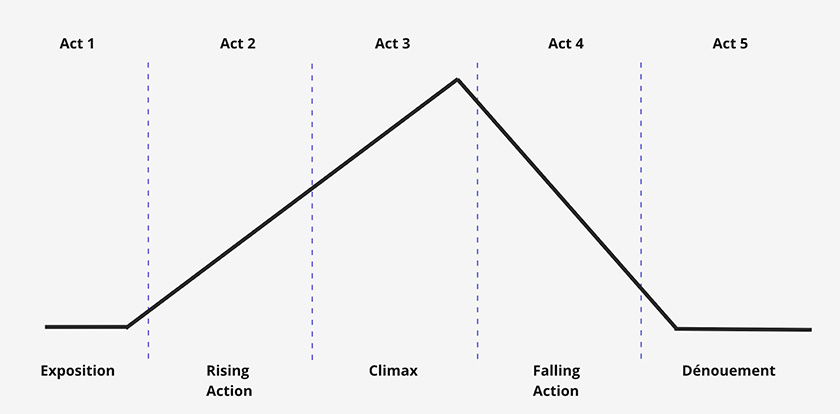
There are five parts to Freytag’s Pyramid, with the climax in the middle of the story. (Source: Celtx)
The three-act structure has a clear beginning, middle, and end of the narrative. This makes it ideal for brands with a straightforward story to tell—usually those with a clear offering that helps resolve a customer’s pain point. The three-act structure has the following parts:
- Setup: The introduction, a catalyst, and the first plot point in setting up the story.
- Confrontation: Challenges or rising action, the midpoint where the character’s goal is threatened, and the second plot point which gives the character the confidence for the next act.
- Resolution: The tension of the first two plot points will unwind, leading to a climax and a resolution.
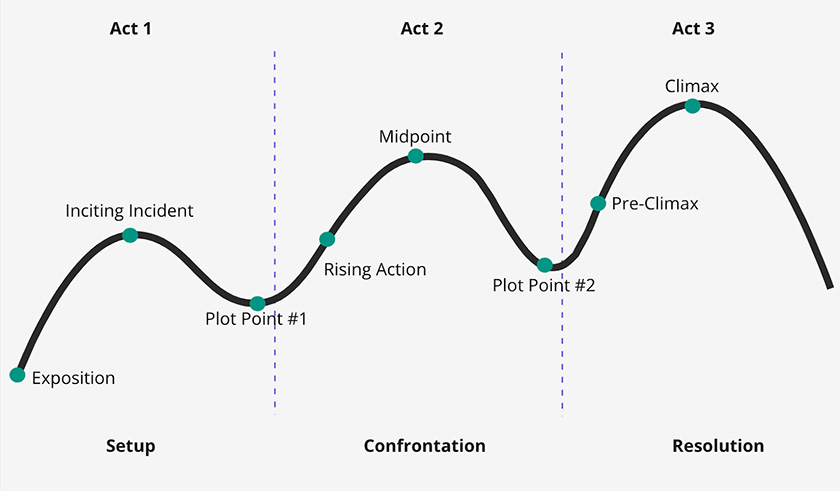
The three-act structure goes in different directions, with one final resolution at the end. (Source: Celtx)
Finally, Pixar’s story framework is inspired by Pixar and Disney movie storytelling, which focuses on creating a compelling narrative that keeps the audience glued to the screen and emotionally invested. It is best for brands with compelling characters or cause-driven stories focusing on values. This story structure follows this template:
Once upon a time, ___________.
And every day, ______________.
Until one day, _______________.
And because of this, __________.
Until finally, _________________.
And ever since then, __________.
Demand generation leader Diandra Escobar gave a clear and succinct translation of this template for brands.
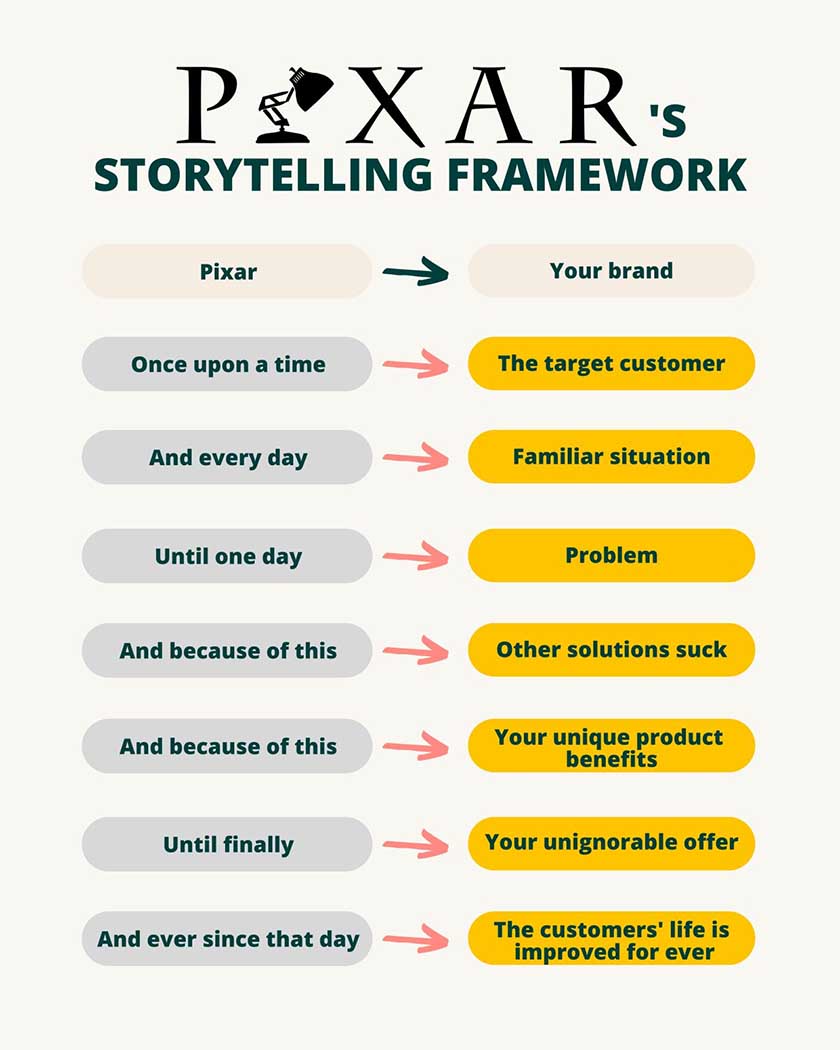
The Pixar Story framework can be used by brands to connect with their audience better. (Source: Diana Escobar)
4. Start With a Hook
Like with all content pieces, first impressions count. A hook is an opening statement meant to reel a reader into reading more about your brand story and create a strong impression. Hooks can be made with a quote, dialogue, or even a rhetorical question. Aim to use visually and emotionally evocative words for your introduction to scream “READ ME!”
Notion’s brand story starts with a simple yet impactful greeting for the reader. This storytelling strategy focuses on establishing a shared experience between the people behind the brand and the people reading the story.

Notion addresses the reader as if they were in conversation. (Source: Notion)
5. Write Like Your Brand
The hard truth about writing a brand story is that there’s no one right way to do it. However, if there’s something I take away from working with numerous brands before who have attempted to write their brand stories, it’s this:
A brand story should not only contain information about your brand. It should sound and feel like the soul of your brand. This will help readers buy into the suggestion that you, and only you, can lead them to a solution for their problems.
Branding statistics even show that being consistent in branding can increase revenue by 20%. Take, for example, Halo Top’s brand story. It’s nothing comprehensive, but what they were able to achieve is to craft a brand story that’s simple and light-hearted—which feels similar to their overall branding for light ice cream.
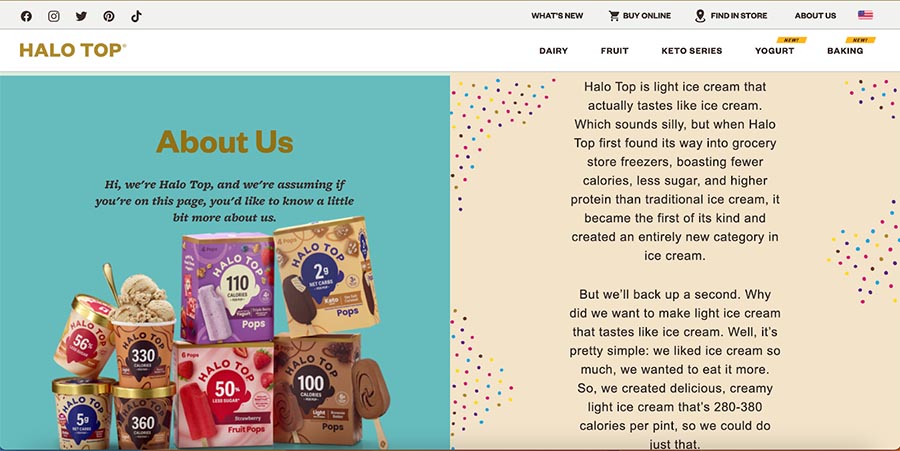
Halo Top’s charming brand story can be found on its About page. (Source: Halo Top)
If you’re having trouble with this step, feel free to use our brand story script template as a starting point. Alternatively, tools like artificial intelligence (AI) content writers can make it easier for businesses to come up with an initial draft. Just remember to always keep your brand identity in mind—since this will guide the tone and feel of your writing.
6. Optimize for Your Target Audience & Goal
If you’ve read other guides on how to create a brand story, you’ll know that this step is often placed at the beginning of the writing process. However, we find that prioritizing this plays into the “sales-feel” of ineffective brand stories. Reserve any optimizations of your brand story until well after you’ve written it. This way, your story will be authentic.
Optimizing your brand story while maintaining authenticity requires answering two main questions:
- Who do you want to connect with the most?
- What do you want them to do after reading your brand story?
Once you have the answers to these questions, you can use the checklist below to optimize for your target audience and goal:
Optimizing a Brand Story
- Have you clearly defined your primary target audience—their interests, values, and challenges?
- Is the language, tone, and style of your brand story tailored to resonate with this specific audience?
- Did you incorporate elements that would capture the interest of your target audience?
- Have you connected your brand’s journey with the needs and desires of your audience?
- Do the emotions conveyed in the story align with the desired emotional response from your target audience?
- Have you outlined clear goals for your brand story, such as encouraging people to learn more about your brand or products?
- Does each element of your narrative contribute to achieving these goals?
- Have you added links to your website, products, or pages to help push your reader to the next step?
- Does the narrative naturally lead toward the desired outcomes, such as visiting your website or engaging on social media?
7. Quality Check Your Work
In his Major League Mindset talks, Andy Neary says, “You capture a buyer’s attention with emotion when you have them saying, ‘This person gets me and is just like me.’ Stories give your audience the ability to put themselves inside the story. When they do that, your ideas and solutions become more realistic, giving the audience the confidence to take the next step.”
According to Neary, a fresh perspective is key to driving the audience to take the next step. Divide your quality check into three phases. Each one helps you bring a fresh perspective to your story. These phases are:
- Brand check: Look back to your brand messaging on other channels, whether it be your website, social media accounts, or email campaigns. Does your brand story align seamlessly with your brand identity?
- Audience feedback: Ask for feedback from a sample audience or a trusted group of people. Do they feel as if they are engaged by and connected to your brand story?
- Refinement: Incorporate the changes you get from brand checking and audience feedback, then sleep on it. Proofread your brand narrative the next day, when you read it again for the first time.
Once you’ve completed the quality check, read your brand story one last time. Make sure it presents a unified, honest, and authentic picture of your brand, your experience, and most importantly, your customer’s buying journey.
Frequently Asked Questions
The purpose of a brand story is to create a narrative that connects with consumers on a deeper level. It goes beyond just showcasing products or services. Brand stories humanize the brand, communicate brand values, and build emotional connections with potential customers. Developing a good brand story can differentiate a company, foster brand loyalty, and firmly plant a brand’s identity in the target audience.
You can structure a brand story by using a narrative structure. This can be the three-act structure (setup, confrontation, and resolution), Freytag’s Pyramid (exposition, rising action, climax, falling action, and resolution), or any other story structure that fits your brand’s preferences.
A successful brand story is clear and authentic and keeps the target audience top of mind. It should be able to communicate the brand’s message and story in an emotional way, positioning your brand as the solution the reader is searching for. This makes your story connect on a deeper level than just a list of facts—or worse, an emotionless timeline.
Bottom Line
Learning how to write a brand story can be challenging. However, following the steps of understanding your brand, using an outline, choosing a story framework, then writing, optimizing, and refining the draft will help yield a clearly structured brand story that communicates how the brand came to life. Alternatively, filling out our brand story template is a fantastic starting point in your journey to creating your brand story.
